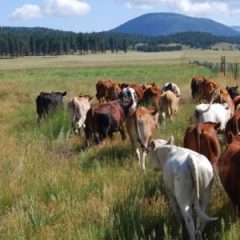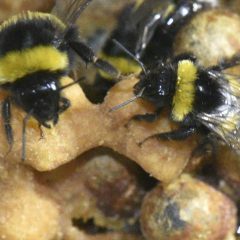A thoughtful new piece published online by Aeon calls for a reboot of how the nation’s livestock farmers do business. Grassland 2.0 calls for our livestock farmers to also become grass farmers. It is a re-invention of a very old wheel: the idea that animals and pasture can work together as a kind of ecosystem. […]
Read More, References, Comment »
New science has, for the first time, replicated in a lab experiment the neural impacts on baby bees triggered when foraging adults are exposed to one type of insecticide. The widely used neonicotinoid (“neonic”) insecticide imidacloprid was the focus of the study done by a team at Imperial College London, whose key finding is summarized […]
Read More, References, Comment »
“Forever chemical” contamination of groundwater is both extremely hazardous and difficult to clean up or otherwise mitigate. They don’t break down, and can continue to move through the hydrogeological system for years, often ending up in wells used for human and livestock drinking water, and crop irrigation. In a compelling, detailed story by Chris Clayton, […]
Read More, References, Comment »
Two years ago in 2017, scientists with the USGS and the University of Iowa first reported that neonicotinoid insecticides were “persistent” in drinking water samples collected at the University’s Iowa City campus during a seven week period after the corn planting season (May-July). The reason why was no mystery — at least 80% of the GMO […]
Read More, References, Comment »
A duo of research scientists from Australian universities have conducted an extensive review of global data on insect populations, with stark results. Their analysis of 73 historical reports was published this month in the journal Biological Conservation. It reveals “dramatic rates of decline that may lead to the extinction of 40% of the world’s insect species over the […]
Read More, References, Comment »
In just a couple more months, Arkansas farmers will be planting soybeans in their fields again. So, that means another contentious round of meetings and hearings so the Arkansas Plant Board can decide how and when soybean farmers will be able to spray dicamba on their fields. The dicamba drift disaster of the last couple […]
Read More, References, Comment »
Phosphorous is a key nutrient promoting plant growth, and a standard ingredient in many fertilizer blends. But if too much phosphorous ends up in the region’s watershed, it can wreck havoc on wetlands, streams, and lakes, causing harmful algae blooms (like the extreme cyanobacteria algae blooms in Lake Erie last year) and depletion of dissolved […]
Read More, References, Comment »
Two new publications were released in the last week that contribute much new food for thought in the global discussion around the sustainability of the Earth’s food systems. First off, on January 16th the Lancet published a special feature called “Food in the Anthropocene: the EAT–Lancet Commission on healthy diets from sustainable food systems.” As Reuters reports, […]
Read More, References, Comment »
Americans enjoy the cheapest food in the world. The American food supply is among the most expensive in the world. Both statements are true. How can that be? America is the richest country in the world, so when the cost of food in the U.S. is measured as a percentage of average per capita income, […]
Read More, References, Comment »
The New York Times reported this week that nitrate contamination of private wells in agricultural regions around the Midwest is turning water quality and agricultural regulations into focal points of many local and statewide elections. In communities surrounding the agricultural regions of Wisconsin, Iowa, and beyond, private wells are failing water quality standards, often by […]
Read More, References, Comment »










